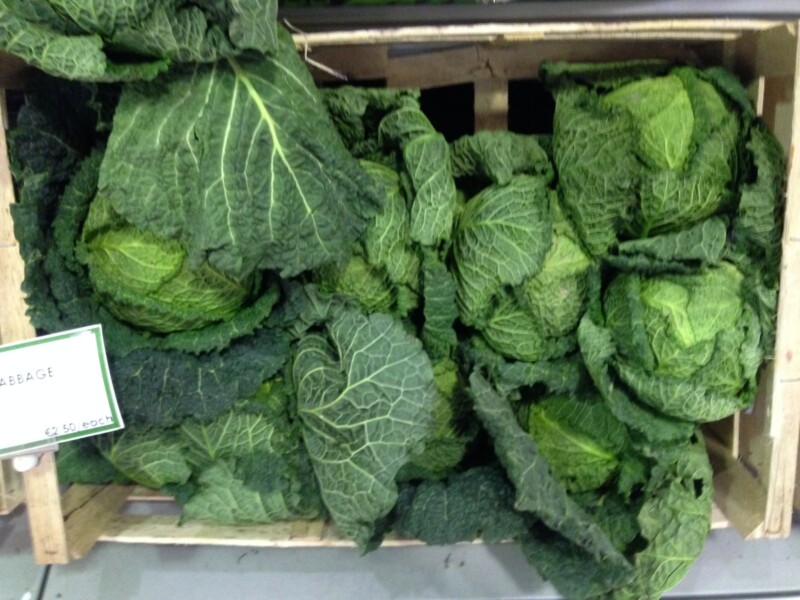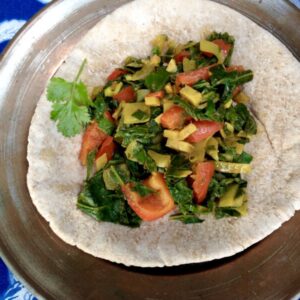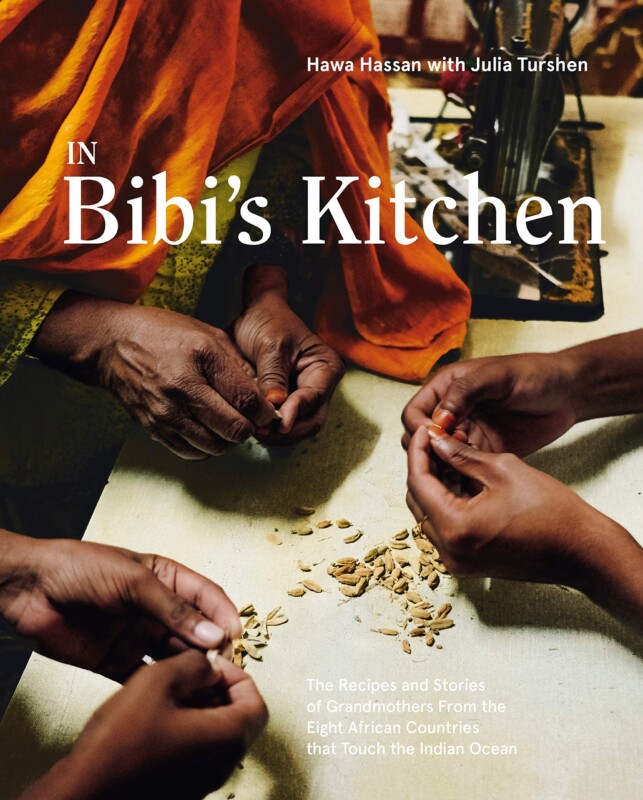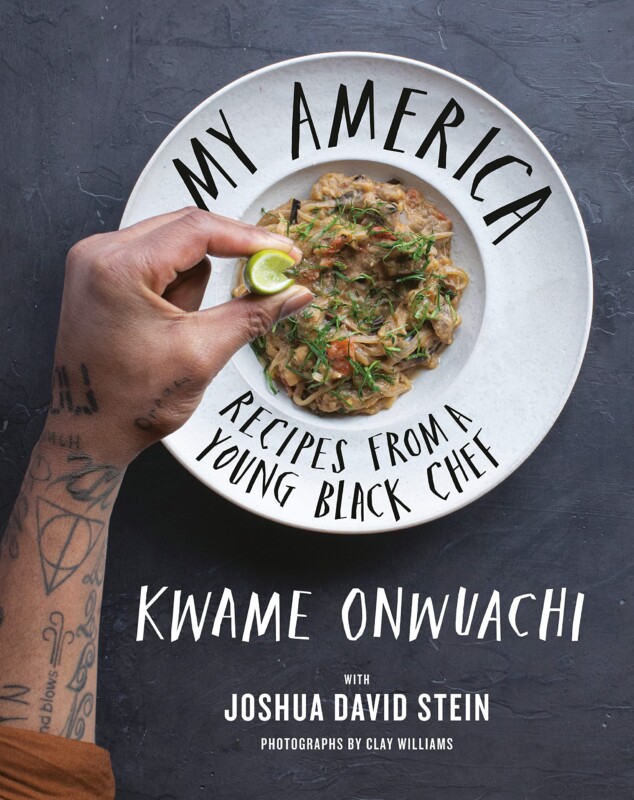We end Black History Month with a Swahili language lesson — sukuma wiki. It means “stretch the week.” It also means stretch your budget and get your greens on. This great dish of the African diaspora is a delicious way to make the most of seasonal, regional greens whatever the season, and wherever you live, from collards to callaloo, spinach to sweet potato.

Sukuma wiki takes greens —any kind and in any combination — and treats them to a quick sauté with aromatics, spices, and tomatoes. The heat tames the greens, and they wilt right down. They’re tender with a bright color and flavor that’s a world away from greens slow-cooked till they’re gray, limp, and defeated. Best of all, sukuma wiki is a week and budget stretcher but a snap to make.
Jump to the recipe or stick around for more sukuma wiki stuff.How to Make Sukuma Wiki
- In a Dutch oven or other large pot with a lid, heat oil over medium-high heat.
- Add the chopped onion and ginger and cook, stirring now and then until they start to soften and turn gold, about 5 minutes.
- Add minced garlic and cumin, coriander and turmeric. Continue stirring and cooking another few minutes, or until all the vegetables are gilded in the spiced oil.
- Add tomatoes, all your greens, and water or broth. Mix together well.
- When the pot comes to simmer, cover, reduce heat to low and let everybody cook for about 15 minutes, until greens are softened, with a flavor that sings of their greenness. If they’ve thrown off a lot of liquid, continue cooking a few minutes more with the lid off, stirring occasionally, so any excess liquid cooks away.
- Turn off the heat, add lemon juice and season generously with sea salt and pepper. Sprinkle in chopped cilantro, if using, stir and serve.
What greens make the best sukuma wiki? Whatever’s in season. Go with a single green or make up a combo of what’s fresh from your garden or farmers market. Kale, cabbage, chard, collards, turnip greens, mustard greens, even hairier, harder to love greens like radish tops respond to a little sukuma wiki love. So do the leafy greens of Africa — baobob, Shona cabbage, jute, molokhia, calalloo and sweet potato.

Greens play a bigger role in the traditional foodways of Africa than they do in the Mediterranean Diet.
Sukuma wiki isn’t the only way Africa does greens. It’s related to Ethiopian gomen wat and njamma jamma, another gift of greens from the African diaspora. Originally from Cameroon, it’s made there with local greens like huckleberry or sweet potato. In the States, it’s usually made with spinach, but it loses nothing in the translation. It’s my favorite thing to eat at New Orleans Jazz and Heritage Festival, with plenty of hot sauce.
In Africa and the Caribbean and even Miami, with its Afro-Caribbean crops and culture, the perfect pairing for sukuma wiki is fufu, dumplings made with green plantain and yucca aka cassava. But it’s equally enjoyable with other belly-fillers like rice, grits, or cornbread. Any way you serve it up, sukuma wiki’s a fitting salute to Black History Month, and a delicious way to get your greens on.

Discover more of Africa’s kitchen riches with Oldways’ African Heritage Diet. Understanding and appreciating its origins makes the foods we love even more delicious.

Sukuma Wiki
Ingredients
- 2 tablespoons grapeseed or coconut oil
- 1 large onion chopped
- 2 garlic cloves minced
- 1 thumb-sized piece of ginger well-chopped
- 1 teaspoon ground cumin
- ½ teaspoon ground coriander
- ½ teaspoon ground turmeric
- 2 large tomatoes coarsely chopped or 1 15-ounce can diced tomatoes
- 1 pound colllards callaloo, kale, or any combination of dark leafy greens, tough stems discarded, well-cleaned and coarsely chopped
- ½ cup water or vegetable broth
- 2 tablespoons fresh lemon juice
- sea salt and fresh ground pepper to taste
- 1 handful cilantro chopped (optional)
Instructions
- In a Dutch oven or other large pot with a lid, heat oil over medium-high heat. Add the chopped onion and ginger and cook, stirring now and then until they start to soften and turn gold, about 5 minutes. Add minced garlic and cumin, coriander and turmeric. Continue stirring and cooking another few minutes, or until all the vegetables are gilded in the spiced oil.
- Add tomatoes, all your greens, and water or broth. Mix together well. When the pot comes to simmer, cover, reduce heat to low and let everybody cook for about 15 minutes, until greens are softened, with a flavor that sings of their greenness. If they’ve thrown off a lot of liquid, continue cooking a few minutes more with the lid off, stirring occasionally, so any excess liquid cooks away.
- Turn off the heat, add lemon juice and season generously with sea salt and pepper. Sprinkle in chopped cilantro, if using, stir and serve.
Notes
More African inspiration
- Yam, black-eyed peas and peanuts, three African crops, come together in this bodacious Kwanzaa Bowl

- Sweet, creamy African-American sweet potato and peanut stew is one of people’s favorites from my book, Feeding the Hungry Ghost
- Curried Caribbean pumpkin dip, known in Trinidad as pumpkin talkari, is luscious starter rich with Afro-Caribbean flavors
- Tanya Holland shows off black-eyed peas and benne, sesame seeds in this recipe from her book, Tanya Holland’s California Soul.
- Taste some Lowcountry love with Gullah Diva Sallie Ann Robinson’s tomato, corn, lima and okra soup.

- Dr. Jessica B. Harris, High on the Hog

- Hawa Hassan, In Bibi’s Kitchen

- Tanya Holland, Miss Tanya Holland’s California Soul

- Kwame Onwuachi, My America

- Matthew Raiford, Bress N’ Nyam

- Toni Tipton-Martin, Jubilee

- Michael Twitty, Koshersoul

Leave a Reply